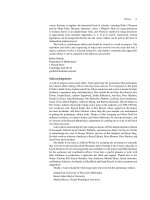Routing and Wavelength Assignment in Optical WDM Networks phần 2 pps
Bạn đang xem bản rút gọn của tài liệu. Xem và tải ngay bản đầy đủ của tài liệu tại đây (61.04 KB, 9 trang )
If a request for a lightpath cannot be accepted because of lack of resources, it is blocked.
Because of the real-time nature of the problem, RWA algorithms in a dynamic traffic environ-
ment must be very simple. Since combined routing and wavelength assignment is a hard problem,
a typical approach to designing efficient algorithms is to decouple the problem into two separate
subproblems: the routing problem and the wavelength assignment problem. Consequently, most
dynamic RWA algorithms for wavelength routed networks consist of the following general steps:
1. Compute a number of candidate physical paths for each source-destination edge node pair
and arrange them in a path list.
2. Order all wavelengths in a wavelength list.
3. Starting with the path and wavelength at the top of the corresponding list, search for a
feasible path and wavelength for the requested lightpath.
The specific nature of a dynamic RWA algorithm is determined by the number of candidate paths
and how they are computed, the order in which paths and wavelengths are listed, and the order in
which the path and wavelength lists are accessed.
Let us first discuss the routing subproblem. If a static algorithm is used, the paths are computed
and ordered independently of the network state. With an adaptive algorithm, on the other hand,
the paths computed and their order may vary according to the current state of the network. A
static algorithm is executed off-line and the computed paths are stored for later use, resulting in low
latency during lightpath establishment. Adaptive algorithms are executed at the time a lightpath
request arrives and require network nodes to exchange information regarding the network state.
Lightpath set up delay may also increase, but in general adaptive algorithms improve network
performance.
The number of path choices for establishing an optical connection is another important param-
eter. A fixed routing algorithm is a static algorithm in which every source-destination edge node
pair is assigned a single path. With this scheme, a connection is blocked if there is no wavelength
available on the designated path at the time of the request. In fixed-alternate routing, a number
k, k > 1, of paths are computed and ordered off-line for each source-destination edge node pair.
When a request arrives, these paths are examined in the specified order and the first one with
a free wavelength is used to establish the lightpath. The request is blocked if no wavelength is
available in any of the k paths. Similarly, an adaptive routing algorithm may compute a single
path, or a number of alternate paths at the time of the request. A hybrid approach is to compute
10
k paths off-line, however, the order in which the paths are considered is determined according to
the network state at the time the connection request is made (e.g., least to most congested).
In most practical cases, the candidate paths for a request are considered in increasing order of
path length. Path length is typically defined as the sum of the weights assigned to each physical
link along the path, and the weights are chosen according to some desirable routing criterion.
Since weights can be assigned arbitrarily, they offer a wide range of possibilities for selecting path
priorities. For example, in a static (fixed-alternate) routing algorithm, the weight of each link could
be set to 1, or to the physical distance of the link. In the former case, the path list consists of the
k minimum-hop paths, while in the latter the candidate paths are the k minimum-distance paths
(where distance is defined as the geographic length). In an adaptive routing algorithm, link weights
may reflect the load or “interference” on a link (i.e., the number of active lightpaths sharing the
link). By assigning small weights to least loaded links, paths with larger number of free channels on
their links rise to the head of the path list, resulting in a least loaded routing algorithm. Paths that
are congested become “longer” and are moved further down the list; this tends to avoid heavily
loaded bottleneck links. Many other weighting functions are possible.
When path lengths are sums of of link weights, the k-shortest path algorithm [18] can be used
to compute candidate paths. Each path is checked in order of increasing length, and the first that
is feasible is assigned the first free wavelength in the wavelength list. However, the k shortest paths
constructed by this algorithm usually share links. Therefore, if one path in the list is not feasible,
it is likely that other paths in the list with which it shares a link will also be infeasible. To reduce
the risk of blocking, the k shortest paths can be computed so as to be pairwise link-disjoint. This
can be accomplished as follows: when computing the i-th shortest path, i = 1, · · · , k, the links used
by the first i − 1 paths are removed from the original network topology and Dijkstra’s shortest path
algorithm [19] is applied to the resulting topology. This approach increases the chances of finding
a feasible path for a connection request.
Let us now discuss the wavelength assignment subproblem which is concerned with the manner
in which the wavelength list is ordered. For a given candidate path, wavelengths are considered
in the order in which they appear in the list to find a free wavelength for the connection request.
Again, we distinguish between the static and adaptive cases. In the static case, the wavelength
ordering is fixed (e.g., the list is ordered by wavelength number). The idea behind this scheme,
also referred to as first-fit, is to pack all the in-use wavelengths towards the top of the list so that
wavelengths towards the end of the list will have higher probability of being available over long
continuous paths. In the adaptive case, the ordering of wavelengths is typically based on usage.
Usage can be defined either as the number of links in the network in which a wavelength is currently
11
used, or as the number of active connections using a wavelength. Under the max-reuse method, the
most used wavelengths are considered first (i.e., wavelength are considered in order of decreasing
usage). The rationale behind this method is to reuse active wavelengths as much as possible before
trying others, packing connections into fewer wavelengths and conserving the spare capacity of less-
used wavelengths. This in turn makes it more likely to find wavelengths that satisfy the continuity
requirement over long paths. Under the min-reuse method, wavelengths are tried in the order
of increasing usage. This scheme attempts to balance the load as equally as possible among all
the available wavelengths. However, min-reuse assignment tends to “fragment” the availability of
wavelengths, making it less likely that the same wavelength is available throughout the network for
connections that traverse longer paths.
The max-reuse and min-reuse schemes introduce communication overhead because they require
global network information in order to compute the usage of each wavelength. The first-fit scheme,
on the other hand, requires no global information, and since it does not need to order wavelengths in
real-time, it has significantly lower computational requirements than either max-reuse or min-reuse.
Another adaptive scheme that avoids the communication and computational overhead of max-reuse
and min-reuse is random wavelength assignment. With this scheme, the set of wavelengths that
are free on a particular path is first determined. Among the available wavelengths, one is chosen
randomly (usually with uniform probability) and assigned to the requested lightpath.
We note that in networks in which all OXCs are capable of wavelength conversion, the wave-
length assignment problem is trivial: since a lightpath can be established as long as at least one
wavelength is free at each link and different wavelengths can be used in different links, the order
in which wavelengths are assigned is not important. On the other hand, when only a fraction of
the OXCs employ converters (i.e., a sparse conversion scenario), a wavelength assignment scheme
is again required to select a wavelength for each segment of a connection’s path that originates and
terminates at an OXC with converters. In this case, the same assignment policies discussed above
for selecting a wavelength for the end-to-end path can also be used to select a wavelength for each
path segment between OXCs with converters.
The performance of a dynamic RWA algorithm is generally measured in terms of the call block-
ing probability, that is, the probability that a lightpath cannot be established in the network due
to lack of resources (e.g., link capacity or free wavelengths). Even in the case of simple network
topologies (such as rings) or simple routing rules (such as fixed routing), the calculation of blocking
probabilities in WDM networks is extremely difficult. In networks with arbitrary mesh topologies,
and/or when using alternate or adaptive routing algorithms, the problem is even more complex.
These complications arise from both the link load dependencies (due to interfering lightpaths) and
12
the dependencies among the sets of active wavelengths in adjacent links (due to the wavelength
continuity constraint). Nevertheless, the problem of computing blocking probabilities in wavelength
routed networks has been extensively studied in the literature, and approximate analytical tech-
niques which capture the effects of link load and wavelength dependencies have been developed
in [8, 9, 20]. A detailed comparison of the performance of various wavelength assignment schemes
in terms of call blocking probability can be found in [21].
Though important, average blocking probability (computed over all connection requests) does
not always capture the full effect of a particular dynamic RWA algorithm on other aspects of net-
work behavior, in particular, fairness. In this context, fairness refers to the variability in blocking
probability experienced by lightpath requests between the various edge node pairs, such that lower
variability is associated with a higher degree of fairness. In general, any network has the property
that longer paths are likely to experience higher blocking than shorter ones. Consequently, the
degree of fairness can be quantified by defining the unfairness factor as the ratio of the blocking
probability on the longest path to that on the shortest path for a given RWA algorithm. Depending
on the network topology and the RWA algorithm, this property may have a cascading effect which
can result in an unfair treatment of the connections between more distant edge node pairs: block-
ing of long lightpaths leaves more resources available for short lightpaths, so that the connections
established in the network tend to be short ones. These shorter connections “fragment” the avail-
ability of wavelengths, and thus, the problem of unfairness is more pronounced in networks without
converters since finding long paths that satisfy the wavelength continuity constraint is more difficult
than without this constraint.
Several studies [8, 9, 20] have examined the influence of various parameters on blocking proba-
bility and fairness, and some of the general conclusions include the following:
• Wavelength conversion significantly affects fairness. Networks employing converters at all
OXCs sometimes exhibit orders of magnitude improvement in fairness (as reflected by the
unfairness factor) compared to networks with no conversion capability, despite the fact that
the improvement in overall blocking probability is significantly less pronounced. It has also
been shown that equipping a relatively small fraction (typically, 20-30%) of all OXCs with
converters is sufficient to achieve most of the fairness benefits due to wavelength conversion.
• Alternate routing can significantly improve the network performance in terms of both overall
blocking probability and fairness. In fact, having as few as three alternate paths for each
connection may in some cases (depending on the network topology) achieve almost all the
benefits (in terms of blocking and fairness) of having full wavelength conversion at each OXC
13
with fixed routing.
• Wavelength assignment policies also play an important role, especially in terms of fairness.
The random and min-reuse schemes tend to “fragment” the wavelength availability, resulting
in large unfairness factors (with min-reuse having the worst performance). On the other
hand, the max-reuse assignment policy achieves the best performance in terms of fairness.
The first-fit scheme exhibits a behavior very similar to max-reuse in terms of both fairness
and overall blocking probability, and has the additional advantage of being easier and less
expensive to implement.
4 Multicast Routing and Wavelength Assignment
In Sections 2 and 3, we considered static and dynamic RWA algorithms, respectively, for establishing
lightpaths in optical networks. In [22], the concept of a lightpath was generalized into that of a light-
tree, which, like a lightpath, is a clear channel originating at given source node and implemented
with a single wavelength. But unlike a lightpath, a light-tree has multiple destination nodes, hence
it is a point-to-multipoint channel. The physical links implementing a light-tree form a tree, rooted
at the source node, rather than a path in the physical topology, hence the name. The study in [22]
focused on virtual topology design (i.e., static RWA) for point-to-point traffic and observed that,
since a light-tree is a more general representation of a lightpath, the set of virtual topologies that can
be implemented using light-trees is a superset of the virtual topologies that can be implemented
only using lightpaths. Thus, for any given virtual topology problem, an optimal solution using
light-trees is guaranteed to be at least as good and possibly an improvement over the optimal
solution obtained using only lightpaths. Furthermore, it was demonstrated that by extending the
lightpath concept to a light-tree, the network performance (in terms of average packet hops) can be
improved while the network cost (in terms of the number of optical transmitters/receivers required)
decreases.
Light-trees are implemented by employing optical devices known as power splitters [2] at the
OXCs. A power splitter has the ability to split an incoming signal, arriving at some wavelength λ,
into up to m outgoing signals, m ≥ 2; m is referred to as the fanout of the power splitter. Each of
these m signals is then independently switched to a different output port of the OXC. Note that due
to the splitting operation and associated losses, the optical signals resulting from the splitting of the
original incoming signal must be amplified before leaving the OXC. Also, to ensure the quality of
each outgoing signal, the fanout m of the power splitter may have to be limited to a small number.
If the OXC is also capable of wavelength conversion, each of the m outgoing signal may be shifted,
14
independently of the others, to a wavelength different than the incoming wavelength λ. Otherwise,
all m outgoing signals must be on the same wavelength λ.
While [22] considered mainly point-to-point traffic, another attractive feature of light-trees is
the inherent capability for performing multicasting in the optical domain (as opposed to performing
multicasting at a higher layer, e.g., the network layer, which requires electro-optic conversion). Such
wavelength routed light-trees are useful for transporting high-bandwidth, real-time applications
such as high-definition TV (HDTV). Therefore, OXCs equipped with power splitters will be referred
to as multicast capable OXCs (MC-OXCs). Note that, just like with converter devices, incorporating
power splitters within an OXC is expected to increase the network cost because of the large amount
of power amplification and the difficulty of fabrication.
With the availability of MC-OXCs and the existence of multicast traffic demands, the problem
of establishing light-trees to satisfy these demands arises. We will call this problem the multicast
routing and wavelength assignment (MC-RWA) problem. MC-RWA bears many similarities to the
RWA problem discussed in Sections 2 and 3. Specifically, the tight coupling between routing and
wavelength assignment remains, and even becomes stronger: in the absence of wavelength conver-
sion the same wavelength must be used by the multicast connection not just along the links of a
single path but along the links of the whole light-tree. Since the construction of optimal trees for
routing multicast connections is by itself a hard problem [23], the combined MC-RWA problem be-
comes even harder. Depending on the nature of traffic demands, we also distinguish between static
and dynamic MC-RWA problems. As we already know, optimal solutions for the point-to-point
RWA problems are not practically obtainable, and with a more general construct (the light-tree)
and hence a much larger search space, this is going to be even more true for the MC-RWA problems.
In general, the approaches to tackling the static and dynamic MC-RWA problems are similar to
the ones we described for the static and dynamic RWA problems, respectively. The challenge in
this case is to design heuristics that can cope with the increased complexity of the problem and yet
produce good solutions. In the following we summarize the recent work on multicasting in optical
networks, but the reader should keep in mind that this is an area of current research.
The benefits of multicasting in wavelength routed optical networks were first demonstrated
in [24]. Specifically, it was shown that using light-trees (spanning the source and destination nodes)
rather than individual parallel lightpaths (each connecting the source to an individual destination)
requires fewer wavelengths and consumes a significantly lower amount of bandwidth. In [25] both
the static and the dynamic MC-RWA problems were studied. A MILP formulation that maximizes
the total number of multicast connections was presented for the static MC-RWA problem. Rather
than providing heuristic algorithms for solving the MILP, bounds on the objective function were
15
presented by relaxing the integer constraints. The dynamic MC-RWA problem, on the other hand,
was solved by decoupling the routing and wavelength assignment problems. A number of alternate
trees was constructed for each multicast connection using existing routing algorithms. When a
request for a connection arrives, the associated trees are considered in a fixed order. For each
tree, wavelengths are also considered in a fixed order (i.e., the first-fit strategy). The connection is
blocked if no free wavelength is found in any of the trees associated with the multicast connection.
Finally, the problem of constructing trees for routing multicast connections was studied in [26]
independently of wavelength assignment, under the assumption that not all OXCs are multicast
capable, i.e., that there is a limited number of MC-OXCs in the network. Four new algorithms
were developed for routing multicast connections under this sparse light splitting scenario. While
the algorithms differ slightly from each other, the main idea to accommodate sparse splitting is to
start with the assumption that all OXCs in the network are multicast capable and use an existing
algorithm to build an initial tree. Such a tree is infeasible if a non-multicast-capable OXC is a
branching point. In this case, all but one branches out of this OXC are removed, and destination
nodes in the removed branches have to join the tree at a MC-OXC.
16
References
[1] T. E. Stern and K. Bala. Multiwavelength Optical Networks. Prentice Hall, Upper Saddle
River, New Jersey, 2000.
[2] B. Mukherjee. Optical Communication Networking. McGraw-Hill, 1997.
[3] O. Gerstel, B. Li, A. McGuire, G. N. Rouskas, K. Sivalingam, and Z. Zhang (Eds.). Special
issue on protocols and architectures for next generation optical WDM networks. IEEE Journal
Selected Areas in Communications, 18(10), October 2000.
[4] G K. Chung, K I. Sato, and D. K. Hunter (Eds.). Special issue on optical networks. Journal
of Lightwave Technology, 18(12), December 2000.
[5] H. Zang, J. P. Jue, and B. Mukherjee. A review of routing and wavelength assignment ap-
proaches for wavelength-routed optical WDM networks. Optical Networks, 1(1):47–60, January
2000.
[6] B. Ramamurty and B. Mukherjee. Wavelength conversion in WDM networking. IEEE Journal
Selected Areas in Communications, 16(7):1061–1073, September 1998.
[7] V. Sharma and E. A. Varvarigos. Limited wavelength translation in all-optical WDM mesh
networks. In Proceedings of INFOCOM ’98, pages 893–901. IEEE, March 1999.
[8] Y. Zhu, G. N. Rouskas, and H. G. Perros. A path decomposition algorithm for computing
blocking probabilities in wavelength routing networks. IEEE/ACM Transactions on Network-
ing, 8(6):747–762, December 2000.
[9] S. Subramaniam, M. Azizoglu, and A. Somani. All-optical networks with sparse wavelength
conversion. IEEE/ACM Transactions on Networking, 4(4):544–557, August 1996.
[10] R. Dutta and G. N. Rouskas. A survey of virtual topology design algorithms for wavelength
routed optical networks. Optical Networks Magazine, 1(1):73–89, January 2000.
[11] R. Ramaswami and K. N. Sivarajan. Design of logical topologies for wavelength-routed optical
networks. IEEE Journal Selected Areas in Communications, 14(5):840–851, June 1996.
[12] E. Leonardi, M. Mellia, and M. A. Marsan. Algorithms for the logical topology design in
WDM all-optical networks. Optical Networks, 1(1):35–46, January 2000.
17
[13] D. Banerjee and B. Mukherjee. A practical approach for routing and wavelength assignment in
large wavelength-routed optical networks. IEEE Journal Selected Areas in Communications,
14(5):903–908, June 1996.
[14] B. Mukherjee et al. Some principles for designing a wide-area WDM optical network.
IEEE/ACM Transactions on Networking, 4(5):684–696, October 1996.
[15] Z. Zhang and A. Acampora. A heuristic wavelength assignment algorithm for multihop WDM
networks with wavelength routing and wavelength reuse. IEEE/ACM Transactions on Net-
working, 3(3):281–288, June 1995.
[16] I. Chlamtac, A. Ganz, and G. Karmi. Lightnets: Topologies for high-speed optical networks.
Journal of Lightwave Technology, 11:951–961, May/June 1993.
[17] S. Banerjee and B. Mukherjee. Algorithms for optimized node placement in shufflenet-based
multihop lightwave networks. In Proceedings of INFOCOM ’93. IEEE, March 1993.
[18] E. Lawler. Combinatorial Optimization: Networks and Matroids. Holt, Rinehart and Winston,
1976.
[19] D. Bertsekas and R. Gallager. Data Networks. Prentice Hall, Inc., Englewood Cliffs, NJ, 1992.
[20] E. Karasan and E. Ayanoglu. Effects of wavelength routing and selection algorithms on wave-
length conversion gain in WDM optical networks. IEEE/ACM Transactions on Networking,
6(2):186–196, April 1998.
[21] Y. Zhu, G. N. Rouskas, and H. G. Perros. A comparison of allocation policies in wavelength
routing networks. Photonic Network Communications, 2(3):265–293, August 2000.
[22] L. H. Sahasrabuddhe and B. Mukherje. Light-trees: Optical multicasting for improved perfor-
mance in wavelength-routed networks. IEEE Communications, 37(2):67–73, February 1999.
[23] S. L. Hakimi. Steiner’s problem in graphs and its implications. Networks, 1:113–133, 1971.
[24] R. Malli, X. Zhang, and C. Qiao. Benefit of multicastsing in all-optical networks. In Proceedings
of SPIE, volume 3531, pages 209–220, November 1998.
[25] G. Sahin and M. Azizoglu. Multicast routing and wavelength assignment in wide-area networks.
In Proceedings of SPIE, volume 3531, pages 196–208, November 1998.
[26] X. Zhang, J. Y. Wei, and C. Qiao. Constrained multicast routing in WDM networks with
sparse light splitting. Journal of Lightwave Technology, 18(12):1917–1927, December 2000.
18









